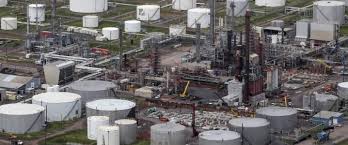Oil & Energy
Why The Energy Sector Is Avoiding Full Emissions Disclosure

The tracking and disclosure of carbon dioxide emissions is at the heart of the energy transition as the first step towards reducing these same emissions. Yet for all the regulatory and activist effort to pressure businesses into full emissions disclosure, it has been tricky, because companies don’t want full emissions disclosure.
A recent study from ESG data provider Clarity AI has revealed that only a tenth of energy companies disclose emissions generated from oil and gas projects in which they participate as investors rather than operators.
The study used data from emission tracker Climate TRACE to show that the great majority of the 20 largest oil and gas companies in the world did not report so-called investment Scope 3 emissions, suggesting this could be problematic for investors.
Scope 3 emissions are the bane of companies’ existence in the current regulatory environment that has prioritized carbon dioxide emissions almost above all else. The pressure to track and report all scopes of emissions is enormous but it is particularly significant in Scope 3: the indirect emissions a company gets on its “bill” from working with suppliers and selling products to clients.
Now, per that Clarity AI study, it emerges that Scope 3 emissions are also the ones generated from projects where companies are only an investor—and they, too, need to be tracked and reported. The idea appears to be that no single molecule of CO2 should go unreported in order to arrest changes in the Earth’s climate.
For obvious reasons, oil and gas companies have been an especially big focus of Scope 3 emission disclosure and reduction efforts due to the nature of their activity, which abounds with all sorts of emissions. For equally obvious reasons, this focus has not made the industry happy, with the general argument being that responsibility for the emissions generated from the use of hydrocarbon products lies with everyone who uses them rather than the ones who produce them.
The reason that oil and gas companies do not want to report their Scope 3 emissions is pretty much the same as the reason for all other companies to be reluctant to do that — the massive amount of resources that would need to go into tracking all indirect emissions a company’s activities produce.
Tracking Scope 3 would involve tracking absolutely every step of the way that a product — or a service — passes from inception to market and that is one quite long way.
The argument of transition advocates is that investors are interested in this sort of information because it helps them make better informed decisions as they increasingly bet on a transition economy. Failing to report Scope 3 emissions, the argument goes, essentially means misleading investors.
Not everyone agrees that reporting all CO2 emissions to the last molecule is all that important, however. “Companies don’t have the incentive to report everything, … just because they don’t have the means to, or haven’t been able to measure it,” said Patricia Pina, the head of Clarity AI’s product research and innovation, told Inside Climate News.
Indeed, some transition advocates attach zero importance to detailed emission reporting, instead prioritizing direct and “decisive” decarbonization.
Commenting on the study to Inside Climate News, the head of the Erasmus platform for sustainable value creation at Ereasmus University in Rotterdam said that while it is understandable why oil and gas companies might not be enthusiastic about Scope 3 reporting, “we don’t really need them to do that. We need them to transition decisively to net zero and to invest massively in renewable energy”.
It appears, then, that not everyone in the pro-decarbonization camp feels equally strongly bout indirect emissions, specifically from investments. Yet the issue could yet become problematic for energy companies if enough pro-transition investors take it to heart as they did all other Scope 3 emissions.
On the flip side, climate-related shareholder resolutions have seen a decline in shareholder support over the past couple of years, which might suggest that investor interest in emissions, direct or indirect, is waning, replaced by things like returns.
This waning interest has coincided with companies beginning to revise their climate commitments, including emission reporting.
The latter trend was detected by the Energy Institute in its latest Statistical Review of World Energy, which revealed that the commitments companies made years ago were unrealistically ambitious.
In a sense, the corporate world woke up to the reality that lightning fast decarbonization is physically impossible and likely financial undesirable.
“Everyone got swept up in a wave of enthusiasm”, the head of sustainable investing research at one Dutch asset manager told the FT last month. “The reality is not so easy”.
Indeed, it appears that enthusiasm for everything from wind and solar to Scope 3 emissions reporting is weakening, to be replaced by a more level-headed approach to energy and corporate management.
By: Irina Slav
Oil & Energy
NCDMB Unveils $100m Equity Investment Scheme, Says Nigerian Content Hits 61% In 2025 ………As Board Plans Technology Challenge, Research and Development Fair In 2026

Oil & Energy
Power Supply Boost: FG Begins Payment Of N185bn Gas Debt

In the bid to revitalise the gas industry and stabilise power generation, President Bola Ahmed Tinubu has authorised the settlement of N185 billion in long-standing debts owed to natural gas producers.
The payment, to be executed through a royalty-offset arrangement, is expected to restore confidence among domestic and international gas suppliers who have long expressed concern about persistent indebtedness in the sector.
According to him, settling the debts is crucial to rebuilding trust between the government and gas producers, many of whom have withheld or slowed new investments due to uncertainty over payments.
Ekpo explained that improved financial stability would help revive upstream activity by accelerating exploration and production, ultimately boosting Nigeria’s gas output adding that Increased gas supply would also boost power generation and ease the long-standing electricity shortages that continue to hinder businesses across the country.
The minister noted that these gains were expected to stimulate broader economic growth, as reliable energy underpins industrialisation, job creation and competitiveness.
In his intervention, Coordinating Director of the Decade of Gas Secretariat, Ed Ubong, said the approved plan to clear gas-to-power debts sends a powerful signal of commitment from the President to address structural weaknesses across the value chain.
“This decision underlines the federal government’s determination to clear legacy liabilities and give gas producers the confidence that supplies to power generation will be honoured. It could unlock stalled projects, revive investor interest and rebuild momentum behind Nigeria’s transition to a gas-driven economy,” Ubong said.
Oil & Energy
The AI Revolution Reshaping the Global Mining Industry

-

 Business4 days ago
Business4 days agoCBN Revises Cash Withdrawal Rules January 2026, Ends Special Authorisation
-
Business4 days ago
Shippers Council Vows Commitment To Security At Nigerian Ports
-

 Business4 days ago
Business4 days agoFIRS Clarifies New Tax Laws, Debunks Levy Misconceptions
-

 Business4 days ago
Business4 days agoNigeria Risks Talents Exodus In Oil And Gas Sector – PENGASSAN
-
Sports4 days ago
Obagi Emerges OML 58 Football Cup Champions
-

 Politics4 days ago
Politics4 days agoTinubu Increases Ambassador-nominees to 65, Seeks Senate’s Confirmation
-
Business4 days ago
NCDMB, Others Task Youths On Skills Acquisition, Peace
-

 Sports3 days ago
Sports3 days agoFOOTBALL FANS FIESTA IN PH IS TO PROMOTE PEACE, UNITY – Oputa

